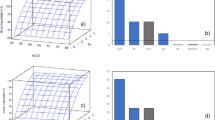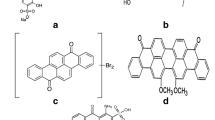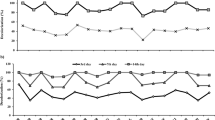Abstract
The effect of various physicochemical parameters was investigated on the removal efficiency of azo dye reactive red 120 from wastewaters by sunflower hairy roots. The highest percentage removal of the colored dye from wastewater(s) was observed at 25 °C, pH 7, adsorbent dosage 12.5 g L−1, shaking speed 85 rpm and light intensity 20 μmol m−2 s−1. Further, a combinatorial study with all the optimized parameters was performed in the dye concentration range of 20–110 mg L−1 to determine the synergistic effect, if any, of all the physicochemical parameters on the kinetics of the dye removal. Nearly 100% dye removal could be achieved in 32 h as opposed to only 54% under the unoptimized conditions. Similarly, the initial dye removal rate could also be enhanced (from 3.4 to 19.6 mg L−1 h−1) under the optimized conditions. This correlated well with the proportionate increase in the (enzymatic and non-enzymatic) antioxidant potential of the root system under the optimized process parameters. The potential degradation of reactive red 120 by sunflower hairy roots was studied by Fourier transformed infrared spectroscopy and scanning electronic microscope analysis. Interestingly, sunflower hairy root system was also able to remove other azo dyes like reactive orange 16 and reactive blue 21 from their aqueous solutions. As seen in the study with reactive red 120, the removal increased from 49.5% under unoptimized conditions to 80.7% under optimized conditions (1.6 fold) for reactive orange 16 and from 55 to 82% (1.5 fold) for reactive blue 21, suggesting that these physicochemical parameters could significantly influence the removal of azo dyes in plant cells and their optimization can lead to further enhancement in the efficiency of the phytoremediation process for azo dye removal. The effect of optimized parameters on the removal of azo dyes from other wastewater compositions (synthetic and actual with different total dissolved solids) was also investigated to check the extrapolation of the key results obtained earlier with an aqueous solution of the dyes. As observed earlier, in a similar combinatorial study, the removal of reactive red 120 (90 mg L−1) could be improved from 72 to 92% (1.2 fold) in its solution in tap water (TDS: 650 ppm), from 26 to 72% (2.8 fold) in its solution in synthetic wastewater (TDS: 950 ppm) and from 41 to 62% in its solution in a secondary treated actual textile wastewater (TDS: 350 ppm).










Similar content being viewed by others
References
Absalan G, Asadi M, Kamran S et al (2011) Removal of reactive red-120 and 4-(2-pyridylazo) resorcinol from aqueous samples by Fe3O4 magnetic nanoparticles using ionic liquid as modifier. J Hazard Mater 192:476–484. https://doi.org/10.1016/j.jhazmat.2011.05.046
Afkhami A, Saber-Tehrani M, Bagheri H (2010) Modified maghemite nanoparticles as an efficient adsorbent for removing some cationic dyes from aqueous solution. Desalination 263:240–248. https://doi.org/10.1016/j.desal.2010.06.065
Ahmed F, Dewani R, Pervez MK et al (2016) Non-destructive FT-IR analysis of mono azo dyes. Bulg Chem Commun 48:71–77
Al-Rubaie LA-AR, Mhessn RJ (2012) Synthesis and characterization of azo dye para red and new derivatives. E-J Chem 9:465–470. https://doi.org/10.1155/2012/206076
Arica TA, Ayas E, Arica MY (2017) Magnetic MCM-41 silica particles grafted with poly(glycidylmethacrylate) brush: Modification and application for removal of direct dyes. Microporous Mesoporous Mater 243:164–175. https://doi.org/10.1016/j.micromeso.2017.02.011
Arica TA, Kuman M, Gercel O, Ayas E (2019) Poly(dopamine) grafted bio-silica composite with tetraethylenepentamine ligands for enhanced adsorption of pollutants. Chem Eng Res Des 141:317–327. https://doi.org/10.1016/j.cherd.2018.11.003
Bayramoglu G, Arica MY (2018) Adsorption of Congo Red dye by native amine and carboxyl modified biomass of Funalia trogii: Isotherms, kinetics and thermodynamics mechanisms. Korean J Chem Eng 35:1303–1311. https://doi.org/10.1007/s11814-018-0033-9
Bazrafshan E, Mostafapour FK, Hosseini AR et al (2013) Decolorisation of Reactive Red 120 dye by using single-walled carbon nanotubes in aqueous solutions. J Chem 2013:1–8. https://doi.org/10.1155/2013/938374
Bhatti HN, Sadaf S, Aleem A (2015) The treatment of textile effluents by low cost agricultural wastes. J Anim Plant Sci 25:284–289
Cardoso NF, Lima EC, Calvete T et al (2011) Application of aqai stalks as biosorbents for the removal of the dyes reactive black 5 and reactive orange 16 from aqueous solution. J Chem Eng Data 56:1857–1868. https://doi.org/10.1021/je100866c
Caretto S, Paradiso A, D’Amico L, De Gara L (2002) Ascorbate and glutathione metabolism in two sunflower cell lines of differing α-tocopherol biosynthetic capability. Plant Physiol Biochem 40:509–513. https://doi.org/10.1016/S0981-9428(02)01419-5
Carias CC, Novais JM, Martins-Dias S (2008) Are Phragmites australis enzymes involved in the degradation of the textile azo dye acid orange 7? Bioresour Technol 99:243–251. https://doi.org/10.1016/j.biortech.2006.12.034
Carliell CM, Barclay SJ, Shaw C et al (1998) The effect of salts used in textile dyeing on microbial decolourisation of a reactive azo dye. Environ Technol (United Kingdom) 19:1133–1137. https://doi.org/10.1080/09593331908616772
Dasgupta J, Singh M, Sikder J et al (2015) Response surface-optimized removal of Reactive Red 120 dye from its aqueous solutions using polyethyleneimine enhanced ultrafiltration. Ecotoxicol Environ Saf 121:271–278. https://doi.org/10.1016/j.ecoenv.2014.12.041
Demirbas E, Nas MZ (2009) Batch kinetic and equilibrium studies of adsorption of Reactive Blue 21 by fly ash and sepiolite. Desalination 243:8–21. https://doi.org/10.1016/j.desal.2008.04.011
Gahlout M, Gupte S, Gupte A (2013) Optimization of culture condition for enhanced decolorization and degradation of azo dye reactive violet 1 with concomitant production of ligninolytic enzymes by Ganoderma cupreum AG-1. 3 Biotech 3:143–152. https://doi.org/10.1007/s13205-012-0079-z
Geethakarthi A, Phanikumar BR (2011) Adsorption of reactive dyes from aqueous solutions by tannery sludge developed activated carbon: kinetic and equilibrium studies. Int J Environ Sci Technol 8:561–570. https://doi.org/10.1007/BF03326242
Gujarathi NP, Haney BJ, Park HJ et al (2005) Hairy roots of Helianthus annuus: a model system to study phytoremediation of tetracycline and oxytetracycline. Biotechnol Prog 21:775–780. https://doi.org/10.1021/bp0496225
Ikeda A (2015) Photon stimulated desorption of and nuclear resonant scattering by noble gas atoms at solid surfaces. University of Tokyo
Jabbar Z, Angham A, Sami GHF (2014) Removal of azo dye from aqueous solutions using chitosan. Orient J Chem 30:571–575. https://doi.org/10.13005/ojc/300222
Jha P, Jobby R, Kudale S et al (2013) Biodegradation of phenol using hairy roots of Helianthus annuus L. Int Biodeterior Biodegrad 77:106–113. https://doi.org/10.1016/j.ibiod.2012.11.001
Kamat RB (2014) Phytoremediation for dye decolorization. Kansas State University
Khandare RV, Govindwar SP (2015) Phytoremediation of textile dyes and effluents: current scenario and future prospects. Biotechnol Adv 33:1697–1714. https://doi.org/10.1016/j.biotechadv.2015.09.003
Kokabian B, Bonakdarpour B, Fazel S (2013) The effect of salt on the performance and characteristics of a combined anaerobic–aerobic biological process for the treatment of synthetic wastewaters containing Reactive Black 5. Chem Eng J 221:363–372. https://doi.org/10.1016/j.cej.2013.01.101
Lokhande VH, Kudale S, Nikalje G et al (2015) Hairy root induction and phytoremediation of textile dye, reactive Green 19A-HE4BD, in a halophyte, Sesuvium portulacastrum (L.). Biotechnol Reports 8:56–63. https://doi.org/10.1016/j.btre.2015.08.002
Mahmoud AS, Ghaly AE, Brooks SL (2007) Influence of temperature and pH on the stability and colorimetric measurement of textile dyes. Am J Biochem Biotechnol 3:33–41. https://doi.org/10.3844/ajbbsp.2007.33.41
Malakootian M, Heidari MR (2018) Reactive orange 16 dye adsorption from aqueous solutions by psyllium seed powder as a low-cost biosorbent: kinetic and equilibrium studies. Appl Water Sci 8:212. https://doi.org/10.1007/s13201-018-0851-2
Meerbergen K, Crauwels S, Willems KA et al (2017) Decolorization of reactive azo dyes using a sequential chemical and activated sludge treatment. J Biosci Bioeng 124:668–673. https://doi.org/10.1016/J.JBIOSC.2017.07.005
Meng X, Liu G, Zhou J et al (2012) Azo dye decolorization by Shewanella aquimarina under saline conditions. Bioresour Technol 114:95–101. https://doi.org/10.1016/j.biortech.2012.03.003
Mondal MIH, Islam MK (2014) Effect of pH on the dye absorption of jute fibre dyed with direct dyes. Orient J Chem 30:1571–1575. https://doi.org/10.13005/ojc/300416
Nadafi K, Vosoughi M, Asadi A et al (2014) Reactive Red 120 dye removal from aqueous solution by adsorption on nano-alumina. J Water Chem Technol 36:125–133. https://doi.org/10.3103/S1063455X14030059
Naveen N, Saravanan P, Baskar G, Renganathan S (2011) Equilibrium and kinetic modeling on the removal of Reactive Red 120 using positively charged Hydrilla verticillata. J Taiwan Inst Chem Eng 42:463–469. https://doi.org/10.1016/J.JTICE.2010.08.007
Obaid MK, Abdullah LC, Idan IJ (2016) Removal of Reactive Orange 16 dye from aqueous solution by using modified Kenaf core fiber. J Chem 2016:4262578. https://doi.org/10.1155/2016/4262578
Ong SA, Uchiyama K, Inadama D et al (2010) Treatment of azo dye Acid Orange 7 containing wastewater using up-flow constructed wetland with and without supplementary aeration. Bioresour Technol 101:9049–9057. https://doi.org/10.1016/j.biortech.2010.07.034
Padmanaban VC, Geed SR, Achary A, Singh RS (2016) Kinetic studies on degradation of Reactive Red 120 dye in immobilized packed bed reactor by Bacillus cohnii RAPT1. Bioresour Technol 213:39–43. https://doi.org/10.1016/j.biortech.2016.02.126
Patil P, Desai N, Govindwar S et al (2009) Degradation analysis of reactive red 198 by hairy roots of Tagetes Patula L. (Marigold). Planta 230:725–735. https://doi.org/10.1007/s00425-009-0980-9
Srikantan C, Suraishkumar GK, Srivastava S (2018) Effect of light on the kinetics and equilibrium of the textile dye (Reactive Red 120) adsorption by Helianthus annuus hairy roots. Bioresour Technol 257:84–91. https://doi.org/10.1016/j.biortech.2018.02.075
Tseng RL, Wu FC, Juang RS (2010) Characteristics and applications of the Lagergren’s first-order equation for adsorption kinetics. J Taiwan Inst Chem Eng 41:661–669. https://doi.org/10.1016/j.jtice.2010.01.014
Wang P, Ma Q, Hu D, Wang L (2015) Removal of Reactive Blue 21 onto magnetic chitosan microparticles functionalized with polyamidoamine dendrimers. React Funct Polym 91–92:43–50. https://doi.org/10.1016/j.reactfunctpolym.2015.04.007
Wanyonyi WC, Onyari JM, Shiundu PM (2014) Adsorption of Congo Red dye from aqueous solutions using roots of Eichhornia crassipes: kinetic and equilibrium studies. Energy Procedia 50:862–869. https://doi.org/10.1016/j.egypro.2014.06.105
Yaseen DA, Scholz M (2018) Treatment of synthetic textile wastewater containing dye mixtures with microcosms. Environ Sci Pollut Res 25:1980–1997. https://doi.org/10.1007/s11356-017-0633-7
Acknowledgments
The authors are grateful to the Department of Biotechnology (DBT) (Project No. BT/PR5835/PID/6/688/2012) and Department of Science and Technology (Project No. SR/FT/LS-52/2012), Government of India, for financial assistance for research involving in vitro cultures of sunflower.
Author information
Authors and Affiliations
Corresponding author
Ethics declarations
Conflict of interest
The authors declare that there is no conflict of interest.
Additional information
Editorial responsibility: Anna Grobelak.
Electronic supplementary material
Below is the link to the electronic supplementary material.
Rights and permissions
About this article
Cite this article
Srikantan, C., Suraishkumar, G.K. & Srivastava, S. A synergistic effect of physicochemical parameters on dye removal and concomitant antioxidant production in sunflower hairy roots. Int. J. Environ. Sci. Technol. 18, 3379–3394 (2021). https://doi.org/10.1007/s13762-020-03032-0
Received:
Revised:
Accepted:
Published:
Issue Date:
DOI: https://doi.org/10.1007/s13762-020-03032-0




